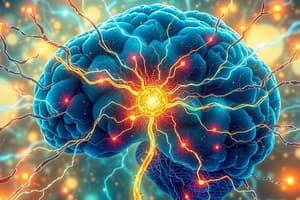Podcast
Questions and Answers
What is the role of acetylcholine as a neurotransmitter?
What is the role of acetylcholine as a neurotransmitter?
- It can be either excitatory or inhibitory.
- It is always inhibiting neurotransmission.
- It is always excitatory. (correct)
- It primarily functions in electrical synapses.
What is a defining characteristic of electrical synapses?
What is a defining characteristic of electrical synapses?
- They always facilitate inhibition of neuronal firing.
- Chemical transmission occurs between neurons.
- The action potential can pass directly between membranes. (correct)
- They involve neurotransmitter release.
What is the Grand Postsynaptic Potential (GPP)?
What is the Grand Postsynaptic Potential (GPP)?
- The strength of an inhibitory signal in a synapse.
- The total excitation that a neuron can generate.
- The potential that determines the rate of neurotransmitter release.
- The sum of all synaptic potentials on a neuron. (correct)
Under what condition will a neuron fire?
Under what condition will a neuron fire?
What occurs when a neuron's postsynaptic potential is facilitated?
What occurs when a neuron's postsynaptic potential is facilitated?
What type of synapse involves the axon of one neuron ending on the soma of another?
What type of synapse involves the axon of one neuron ending on the soma of another?
Which of the following synapse types terminates on the dendrite of another neuron?
Which of the following synapse types terminates on the dendrite of another neuron?
In which scenario is a neuron said to be 'facilitated'?
In which scenario is a neuron said to be 'facilitated'?
What best describes an axoaxonic synapse?
What best describes an axoaxonic synapse?
What determines whether a neuron will not have a GPP?
What determines whether a neuron will not have a GPP?
Flashcards are hidden until you start studying
Study Notes
Transmission of Nerve Impulses
- Action potential reaches the presynaptic terminal, opening voltage-gated calcium channels.
- Calcium influx triggers synaptic vesicles to fuse with the membrane (exocytosis).
- Neurotransmitters are released into the synaptic cleft, diffusing to the postsynaptic terminal.
- Binding of neurotransmitters to neuroreceptors causes Na+ channels to open, leading to an influx of sodium ions.
- If the threshold is reached, an action potential is initiated in the postsynaptic neuron.
- Neurotransmitters are broken down by specific enzymes in the synaptic cleft.
- Cholinergic synapses primarily release acetylcholine (ACh), facilitating information transfer across the synaptic cleft.
- Synaptic delay occurs due to the time taken for calcium influx and neurotransmitter release.
- Choline from broken down ACh is reabsorbed and recycled by presynaptic neurons.
- Synaptic fatigue can occur when ACh stores are depleted.
Types of Synapses
-
Fundamental Classification:
- Chemical Synapse: Involves neurotransmitter release from presynaptic neurons to receptors on postsynaptic cells, influencing cell activity.
- Electrical Synapse: Direct connection between membranes allowing electrical current to pass, resulting in rapid signal transmission.
-
Working Classification:
- Excitatory Ion Channel Synapses: Neuroreceptors are Na+ channels; opening leads to local depolarization and potential action action.
- Inhibitory Ion Channels: Not detailed but typically reduce the likelihood of action potentials.
- Non-Channel Synapses: Function through different mechanisms, specifics not provided.
- Neuromuscular Junctions: Specialized connections between neurons and muscles.
- Electrical Synapses: Direct membrane contact allows for fast electrical signal transfer.
Membrane Potential and Summation
- Resting membrane potential is approximately -65 millivolts.
- Excitatory postsynaptic potential (EPSP) occurs when Na+ influx neutralizes negativity.
- Action potentials require simultaneous activation of 40 to 80 terminals via a process called summation.
- Spatial Summation: Summation of signals from multiple synaptic terminals activating widely spaced membrane areas.
- Temporal Summation: Rapid firing from a single presynaptic terminal within a brief period enhances potential effects.
Grand Postsynaptic Potential (GPP)
- A neuron can receive thousands of synaptic inputs, leading to a collective effect known as the Grand Postsynaptic Potential (GPP).
- GPP determines whether the neuron fires: more excitatory inputs than inhibitory ones will result in firing, while the reverse will inhibit it.
- Neurons can exhibit “facilitation” when the summed potential approaches firing threshold but is insufficient; subsequent excitatory signals may easily trigger action potentials.
Anatomical Classification of Synapses
- Axosomatic Synapse: Axon terminates on the soma of another neuron.
- Axodendritic Synapse: Axon ends on the dendrite of the next neuron.
- Axoaxonic Synapse: Axon terminates on another neuron's axon.
- Dendrodendritic Synapse: Connections between dendrites of different neurons.
Studying That Suits You
Use AI to generate personalized quizzes and flashcards to suit your learning preferences.




